
Click here to download a PDF of Practice Test 3
Section I
The Exam
AP® Physics 1 Exam
SECTION I: Multiple-Choice Questions
At a Glance
Total Time
90 minutes
Number of Questions
50
Percent of Total Grade
50%
Writing Instrument
Pen required
Section I of this examination contains 50 multiple-choice questions. Fill in only the ovals for numbers 1 through 50 on your answer sheet.
CALCULATORS MAY BE USED ON BOTH SECTIONS OF THE AP PHYSICS 1 EXAM.
Indicate all of your answers to the multiple-choice questions on the answer sheet. No credit will be given for anything written in this exam booklet, but you may use the booklet for notes or scratch work. Please note that there are two types of multiple-choice questions: single-select and multi-select questions. After you have decided which of the suggested answers is best, completely fill in the corresponding oval(s) on the answer sheet. For single-select, you must give only one answer; for multi-select you must give BOTH answers in order to earn credit. If you change an answer, be sure that the previous mark is erased completely. Here is a sample question and answer.
Sample Question
Chicago is a
(A) state
(B) city
(C) country
(D) continent
Sample Answer

Use your time effectively, working as quickly as you can without losing accuracy. Do not spend too much time on any one question. Go on to other questions and come back to the ones you have not answered if you have time. It is not expected that everyone will know the answers to all the multiple-choice questions.
Many candidates wonder whether or not to guess the answers to questions about which they are not certain. Multiple-choice scores are based on the number of questions answered correctly. Points are not deducted for incorrect answers, and no points are awarded for unanswered questions. Because points are not deducted for incorrect answers, you are encouraged to answer all multiple-choice questions. On any questions you do not know the answer to, you should eliminate as many choices as you can, and then select the best answer among the remaining choices.
ADVANCED PLACEMENT PHYSICS 1 TABLE OF INFORMATION

ADVANCED PLACEMENT PHYSICS 1 EQUATIONS
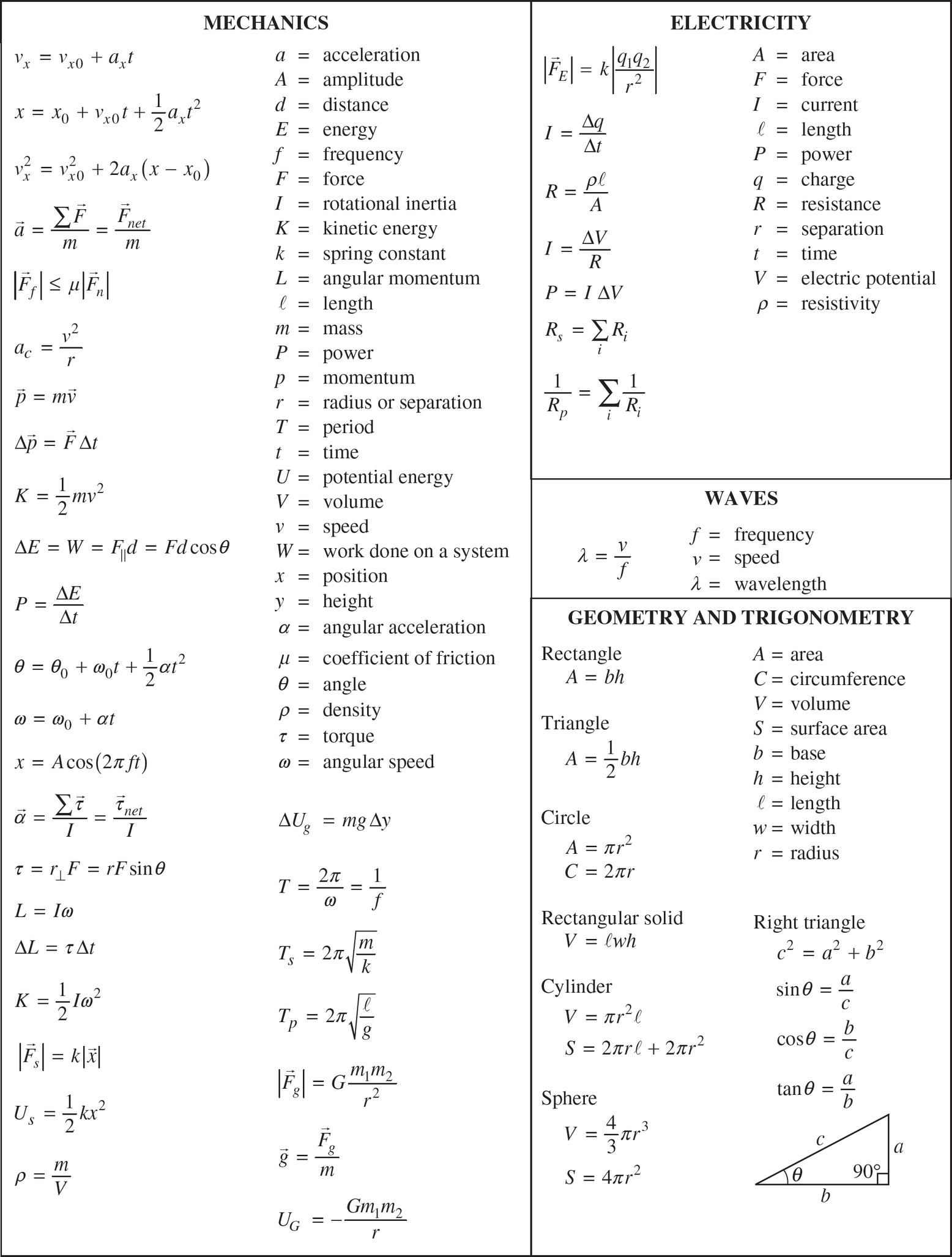
AP PHYSICS 1
SECTION I
Note: To simplify calculations, you may use g = 10 m/s2 in all problems.
Directions: Each of the questions or incomplete statements is followed by four suggested answers or completions. Select the one that is best in each case and then fill in the corresponding circle on the answer sheet.
1. A section of a river flows with a velocity of 1 m/s due S. A kayaker who is able to propel her kayak at 1.5 m/s wishes to paddle directly east one bank to the other. In what direction should she direct her kayak?
(A) 37° N of E
(B) 42° N of E
(C) 45° N of E
(D) 48° N of E
2. An object’s initial velocity is in the second quadrant, with components v1x = −1, v1y = 4. Its final velocity is in the fourth quadrant, with components v2x = 4, v2y = −2. What is the direction of its average acceleration relative to the +x-axis?
(A) 50.2°
(B) 39.8°
(C) −39.8°
(D) −50.2°
3. A student lives 1.2 km from school. On a particular day it takes her 10 min to get from home to school. Which of the following must be true about this trip to school?
I. She travelled a distance of 1.2 km.
II. Her average speed was 2 m/s.
III. The magnitude of her average velocity was 2 m/s.
(A) I only
(B) II and III only
(C) III only
(D) I, II, and III
4. In which of the following position-versus-time graphs does the object in motion have a constant negative acceleration?

5. In which section of the following velocity-versus-time graph is the object speeding up and moving in the negative direction?

(A) Section 1
(B) Section 2
(C) Section 3
(D) Section 4
6. An airtanker is being used to fight a forest fire. It is flying with a ground speed of 85 m/s and maintaining an altitude of 300 m. If it is flying directly towards the fire, at what approximate horizontal distance from the fire should its tanks be open in order for the water dropped to land on the fire? (Assume that the fire is relatively localized.)
(A) 230 m
(B) 250 m
(C) 660 m
(D) 1,700 m
7. Two cannons are fired from a cliff at a height of 50 m from the ground. Cannonball A is fired horizontally with an initial velocity of 40 m/s. Cannonball B is fired at a launch angle of 60° with an initial velocity of 80 m/s. Which cannonball will have a greater magnitude of displacement after two seconds?
(A) Cannonball A
(B) Cannonball B
(C) Both cannonballs will have the same displacement.
(D) Cannot be determined
8. A car initially at rest accelerates linearly at a constant rate for eight seconds. If the total displacement of the car was 600 m, what was the speed of the car after the eight seconds of acceleration?
(A) 50 m/s
(B) 100 m/s
(C) 150 m/s
(D) 200 m/s

9. A car travelling at a speed of v0 applies its brakes, skidding to a stop over a distance of x m. Assuming that the deceleration due to the brakes is constant, what would be the skidding distance of the same car if the braking were twice as effective (doubling the magnitude of deceleration)?
(A) 0.25x m
(B) 0.5x m
(C) x m
(D) 2x m
10. A student is pushing a 3-kg book across a table with a constant force of 30.0 N directed 10° below the horizontal. The coefficient of kinetic friction between the book and the table is 0.3. What is the magnitude of the force that the table exerts on the book during this motion?
(A) 30.7 N
(B) 37.0 N
(C) 38.2 N
(D) 45.0 N

11. A box with a mass of 2 kg is placed on an inclined plane that makes a 30° angle with the horizontal. What must the coefficient of static friction (μs) between the box and the inclined be in order for the box to be at rest?
(A) 0.5
(B) 0.58
(C) 0.87
(D) 1
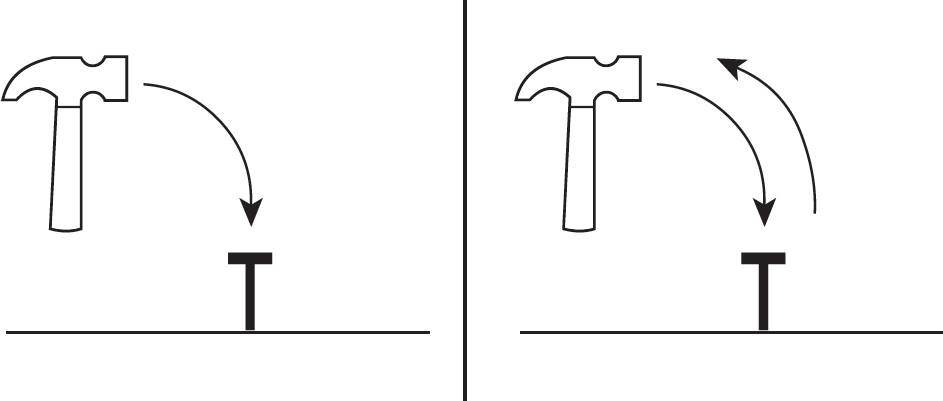
12. A construction worker strikes a nail with a hammer twice with the same initial velocity (vi). The first time, the hammer comes to rest after hitting the nail. The second time, the hammer recoils after hitting the nail and bounces back toward the worker. Assuming the contact time in both strikes is the same, in which strike did the nail exert a greater force on the hammer?
(A) The first strike
(B) The second strike
(C) The nail exerted the same force for both strikes.
(D) Cannot be determined
13. A box with a mass of 5 kg is sliding across a table at a speed of 2 m/s. The coefficient of kinetic friction between the book and table is μ = 0.25. What is the minimum force that has to be applied on the box to maintain this speed?
(A) 0 N
(B) 10 N
(C) 12.5 N
(D) 25 N
14. Two students each push a 30 kg box across the room. Student A applies a constant force of 30 N. Student B starts with a force of 40 N but gradually reduces the force due to fatigue. Given the force-versus-position graphs of the two students, at what position have both students done the same amount of work?

(A) 2 m
(B) 3 m
(C) 4 m
(D) 5 m
15. A 2000 kg truck is initially traveling with a speed of 20 m/s. The driver applies the brake and the truck slows to 10 m/s. How much work was done by the frictional force applied from the brakes?
(A) −300,000 J
(B) −100,000 J
(C) 100,000 J
(D) 300,000 J

16. A box of mass m slides down a frictionless inclined plane of length L and height h. If the box is initially at rest, what is the speed of the box halfway down the inclined plane?
(A) 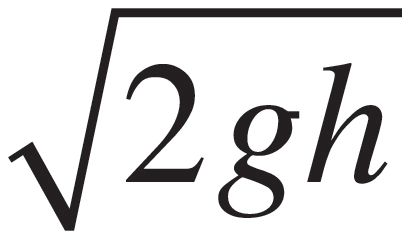
(B) 
(C) 
(D) 
17. A car with a mass of 1000 kg experiences a frictional force of 3500 N while driving at a constant speed of a 15 m/s. What is the power output of the car’s engine?
(A) 3.5 kW
(B) 5.25 kW
(C) 35.0 kW
(D) 52.5 kW
18. A student launched a small rocket with a mass of 50 kg into the air with an initial velocity of 10 m/s in the positive vertical direction. The student then turns on the secondary engines of the rocket to apply a constant upwards force that increases the velocity of the rocket to 15 m/s. If the force provided by the secondary engines did 4,500 J of work, how much work did the force of gravity do on the rocket?
(A) −625 J
(B) −750 J
(C) −1,250 J
(D) −1,375 J
19. A student drops a 1 kg rock off a cliff with a height of 20 m. The rock lands on the ground and comes to rest in 0.25 seconds. What was the magnitude of the average force that the rock experienced while coming to rest?
(A) 20 N
(B) 40 N
(C) 80 N
(D) 160 N
20. A plutonium atom with a mass of 244 Da (daltons) is initially at rest. The atom suddenly undergoes alpha decay, emitting an alpha particle with a mass of 4 Da with a velocity of 45 m/s east. What is the velocity of the decay product with a mass of 240 Da?
(A) 0.75 m/s west
(B) 0.75 m/s east
(C) 0.66 m/s west
(D) 0.66 m/s east
21. A 2000 kg truck traveling north at 40.0 m/s collides with a 1500 kg car traveling west at 20.0 m/s. If the two vehicles lock bumpers and stick together, what is the angle of the velocity after impact?
(A) 69.4° north of west
(B) 20.6° north of west
(C) 20.6° north of east
(D) 69.4° north of east
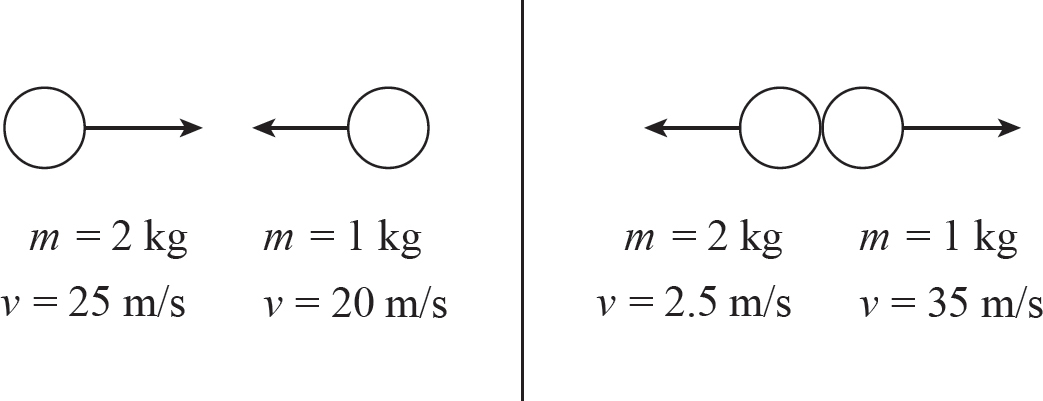
22. A 2 kg ball traveling at 25 m/s collides head on with a 1 kg ball traveling at 20 m/s. After impact, both objects reverse direction with the 2 kg ball traveling at 2.5 m/s and the 1 kg ball traveling at 35 m/s. What type of collision occurred?
(A) Inelastic
(B) Perfectly inelastic
(C) Elastic
(D) Cannot be determined
23. Which of the following statements is FALSE regarding perfectly inelastic collisions?
(A) The objects stick together and travel in the same direction.
(B) Momentum is conserved.
(C) Kinetic energy is conserved.
(D) The maximum amount of kinetic energy is lost.
24. A 0.145 kg baseball is travelling at 40 m/s horizontally when it is struck by a baseball bat. The baseball leaves the bat at 50 m/s back in the direction it came from, but at an angle of 40° above the horizontal. What is the magnitude of the impulse imparted to the baseball?
(A) 1.45 N·s
(B) 4.66 N·s
(C) 12.3 N·s
(D) 13.1 N·s

25. Object 1 travels with an initial speed of v0 toward Object 2, which is traveling in the same direction as Object 1. Object 1 collides perfectly inelastically into Object 2 and the velocity after impact is 0.5v0. If Object 2 has twice the mass of Object 1, what must have been the initial speed of Object 2 (assuming no external forces)?
(A) 0.25v0
(B) 0.5v0
(C) 0.75v0
(D) v0
26. A 2 kg object is tied to a machine with a 0.5 m long string. The machine whirls the object in a horizontal circle at various speeds according to the speed-versus-time graph below. What is the magnitude of the centripetal acceleration of the 2 kg object at t = 3 s ?
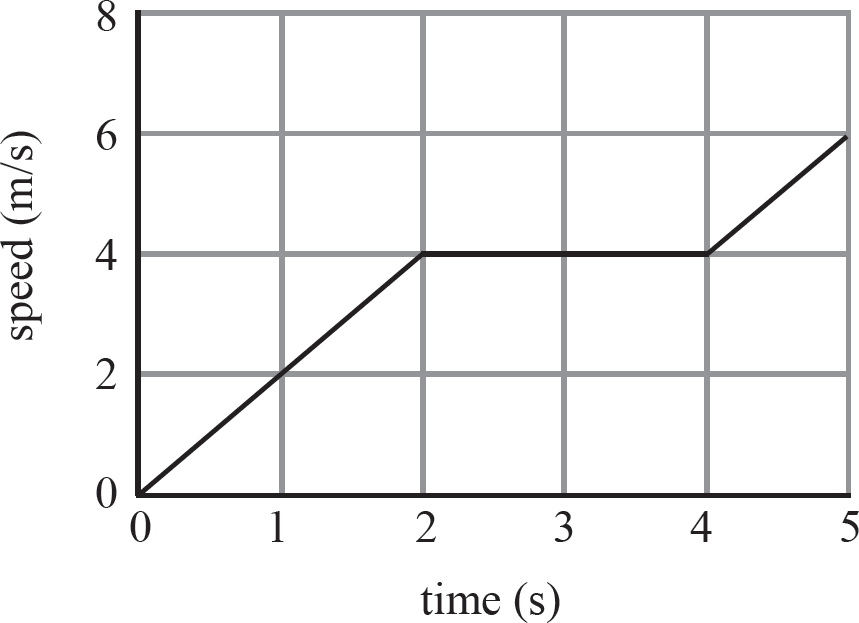
(A) 0 m/s2
(B) 8 m/s2
(C) 16 m/s2
(D) 32 m/s2
27. A student attaches a 1.5 kg mass to a 40 cm long string. The student then begins to whirl the mass in a horizontal circle with increasing speed. If the string snaps when the mass has a speed of 6 m/s, what is the breaking strength of the string?
(A) 22.5 N
(B) 135 N
(C) 240 N
(D) 360 N
28. A planetoid orbits a planet in a circular path at constant speed. The planet has a mass of 4 × 1020 kg and a radius of 1.6 × 105 m. What is the speed of the moon if the planetoid is 3.2 × 105 m above the surface of the planet?
(A) 72 m/s
(B) 193 m/s
(C) 236 m/s
(D) 439 m/s
29. The magnitude of the gravitational force between two objects is F. If the distance between the two objects is tripled and the mass of one of the objects is doubled, what is the new magnitude of the gravitational force between the two objects?
(A) 
(B) 
(C) 
(D) 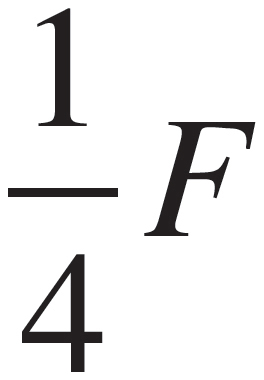
30. A mechanical wheel initially at rest on the floor begins rolling forward with an angular acceleration of 2π rad/s2. If the wheel has a radius of 2 m, what distance does the wheel travel in 3 seconds?
(A) 4π m
(B) 6π m
(C) 16π m
(D) 18π m

31. Three masses are attached to a 1.5 m long massless bar. Mass 1 is 2 kg and is attached to the far left side of the bar. Mass 2 is 4 kg and is attached to the far right side of the bar. Mass 3 is 4 kg and is attached to the middle of the bar. At what distance from the far left side of the bar can a string be attached to hold the bar up horizontally?
(A) 0.3 m
(B) 0.6 m
(C) 0.9 m
(D) 1.2 m
32. A 10 kg mass is attached to the ceiling with two strings (shown below). If the system is in static equilibrium, what is the tension in each of the strings?

(A) 50 N
(B) 70.7 N
(C) 100 N
(D) 141.4 N
33. A student observes that a block oscillating on the end of a spring with an amplitude of 20 cm has a period 0.25 s. What is the period of the same oscillating block if the amplitude is increased to 60 cm ?
(A) 0.25 s
(B) 0.75 s
(C) 1.5 s
(D) Cannot be determined

34. A horizontal spring with a block attached to the end has a natural length of 10 cm. When the spring is attached to the ceiling, the natural length increases by 2 cm. If the spring constant of the block is 50 N/m, what is the mass of the block?
(A) 0.01 kg
(B) 0.05 kg
(C) 0.1 kg
(D) 0.5 kg
35. A simple pendulum is constructed with a 3 kg mass attached to the ceiling with a 25 cm long string. What is the magnitude of the restoring force acting on the mass when the angle to the vertical is 30° ?
(A) 1.5 N
(B) 3 N
(C) 6 N
(D) 15 N
36. A block attached to an ideal spring undergoes simple harmonic motion about its equilibrium position (x = 0) with amplitude A. What fraction of the total energy is in the form of potential energy when the block is at position  ?
?
(A) 
(B) 
(C) 
(D) 
37. If the distance between a crest and an adjacent trough is 0.5 m, what is the wavelength of the wave?
(A) 0.25 m
(B) 0.5 m
(C) 1 m
(D) 2 m
38. The speed of a transverse wave on a stretched string is v. If the string is replaced with one half of the linear density and the tension in the string is doubled, what is the new speed of the transverse wave?
(A) 
(B) 
(C) v
(D) 2v
39. What is the difference between the wavelengths of the 3rd and 4th harmonics of a standing wave fixed at both ends?
(A) 
(B) 
(C) 
(D) 
40. A speaker is projecting a sound wave through the air in the +x-direction. The energy of the sound wave is then increased. Which of the following best describes the resulting change to the wave?
(A) The frequency of the sound wave is increased.
(B) The air molecules move with greater velocity in the +x-direction.
(C) The air molecules oscillate through a larger displacement in the yz-plane.
(D) The air molecules oscillate through a larger displacement in the x-direction.
41. A car traveling at 30 m/s is playing loud music with its speakers. What must the magnitude and direction of the velocity of a truck be in order for its passengers to hear the music emitted from the car with no change in the frequency?
(A) 30 m/s in the same direction as the car
(B) 30 m/s in the opposite direction of the car
(C) 60 m/s in the same direction as the car
(D) 60 m/s in the opposite direction of the car
42. As a train approaches the next stop, the conductor blows the horn and applies the brakes on the train. What will a person standing at the train stop hear as the train approaches?
(A) A decrease in the frequency and an increase in the intensity of the horn
(B) An increase in the frequency and a decrease in the intensity of the horn
(C) A decrease in both the frequency and intensity of the horn
(D) An increase in both the frequency and intensity of the horn

43. Two resistors, R1 and R2, have equal resistance, and are connected in a circuit with a battery as shown in the figure above. If a third resistor, also with the same resistance, is then connected to the circuit, as shown, what happens to the energy E1 and E2 dissipated by R1 and R2, respectively, during a given time interval?
(A) E1 and E2 both decrease.
(B) E1 remains constant while E2 decreases.
(C) E1 decreases while E2 remains constant.
(D) E1 and E2 both remain constant.
44. If the voltage drop across a 3 Ω resistor is 2 V, how long will it take for the resistor to dissipate 100 J of energy?
(A) 75 s
(B) 100 s
(C) 125 s
(D) 150 s

45. A 10 V battery is connected to two 5 Ω resistors in series. Separately, another 10 V battery is connected to two 5 Ω resistors in parallel. What is the difference between the total current produced in each circuit?
(A) 1 A
(B) 2 A
(C) 3 A
(D) 4 A
Directions: For each of the questions 46–50, two of the suggested answers will be correct. Select the two answers that are best in each case, and then fill in both of the corresponding circles on the answer sheet.
46. If vector A has components (5, 3), for which of the following vectors B would the magnitude of the vector sum of A + B be equal to  ? Select two answers.
? Select two answers.
(A) B = (−4, 3)
(B) B = (1, −3)
(C) B = (−6, −9)
(D) B = (1, 3)

47. Consider two small spheres, one carries a charge of q1 = +4 q and the other a charge of q2 = −2 q, separated by a distance of x. Which of the following changes can double the magnitude of the electric field at the midpoint between the two charges? Select two answers.
(A) Increasing the magnitude of q1 by a factor of 4
(B) Increasing the magnitude of q1 by a factor of 2.5
(C) Increasing the magnitude of q2 by a factor of 2.5
(D) Increasing the magnitude of q2 by a factor of 4
48. For which combination of springs will the effective spring constant be equal to 2k ? Select two answers.

49. Which of the following must be true for an object at translational equilibrium? Select two answers.
(A) The kinetic energy of the object is 0.
(B) The net force on the object is 0.
(C) The acceleration of the object is 0.
(D) The net torque on the object is 0.
50. Which of the following changes if implemented would increase the frequency of the oscillations of a simple pendulum? Select two answers.
(A) Increasing the mass of the weight attached to the string
(B) Increasing gravitational acceleration
(C) Increasing the length of the pendulum
(D) Decreasing the length of the pendulum
END OF SECTION I
DO NOT CONTINUE UNTIL INSTRUCTED TO DO SO.
Section II
AP PHYSICS 1
SECTION II
Free-Response Questions
Time—90 minutes
Percent of total grade—50
General Instructions
Use a separate piece of paper to answer these questions. Show your work. Be sure to write CLEARLY and LEGIBLY. If you make an error, you may save time by crossing it out rather than trying to erase it.
AP PHYSICS 1
SECTION II
Directions: Questions 1, 2, and 3 are short free-response questions that require about 13 minutes to answer and are worth 8 points each. Questions 4 and 5 are long free-response questions that require about 25 minutes each to answer and are worth 13 points each. Show your work for each part in the space provided after that part.
1. The motion of an object is given by the following velocity-versus-time graph.

(a) What is the displacement of the object from time t = 0 s to t = 6 s in the graph above?
(b) At what times is the speed of the object increasing?
(c) Make of a sketch of the object’s position-versus-time graph during the time interval of t = 0 s to t = 6 s. Assume that the car begins at x = 0.
2. A small box of mass m is placed on an inclined plane with an angle of incline of θ. There is a coefficient of kinetic friction μk between the inclined plane and the small box. The small box is attached to a much heavier box of mass 3m by a pulley system shown below.
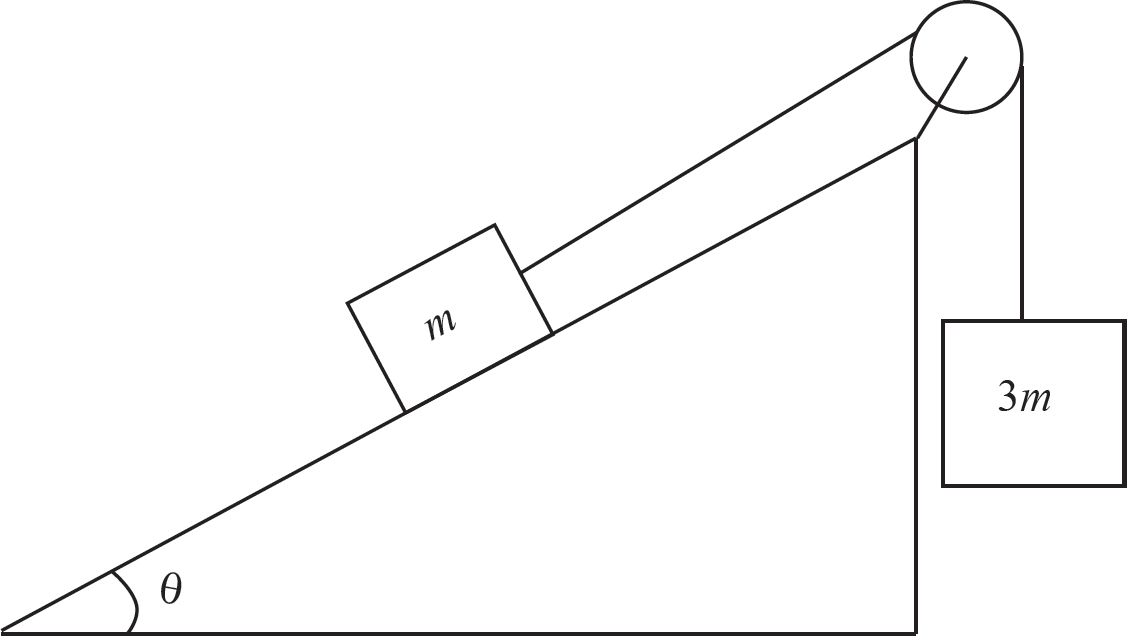
(a) Draw free-body diagrams of both masses, including all of the forces acting on each.
(b) Assuming a frictionless, massless pulley, determine the acceleration of the blocks once they are released from rest in terms of μk, g, and θ.
(c) If μk = 0.3 and θ = 45°, what distance is traveled by the blocks 3 s after being released from rest?
3. A cannon is used to launch a speaker emitting 3 kHz waves with a vertical velocity of 80 m/s. There is a stationary detector on the ground by the cannon.
(a) What is the frequency of the waves received by the detector 8 s after the speaker is launched?
(b) If the speaker begins simultaneously emitting 3.6 kHz waves, what will be the value of the beat frequency produced at the speaker?
(c) If the intensity of the sound received by the detector when the speaker reaches its maximum height is 8 × 10−9 W/m2, what is the intensity received by the detector when the speaker is at half of its maximum height?
4. Consider the following circuit:

(a) Determine the current that passes through R3 and R1.
(b) At what rate does R4 resistor dissipate energy?
(c) What is the voltage read by the voltmeter in the circuit?
(d) In order to minimize the impact of the voltmeter on the circuit, should the voltmeter have a very high or very low internal resistance?
5. Two spheres (one hollow, one solid) are placed side by side on an inclined plane and released at the same time. Both spheres roll down the inclined plane without slipping.
(a) Using a free-body diagram, explain what force provides the torque allowing the spheres to roll down the inclined plane.
(b) Which sphere reaches the bottom of the inclined plane first and why?
(c) How do the kinetic energies of the two spheres compare at the bottom of the inclined plane?
STOP
END OF EXAM